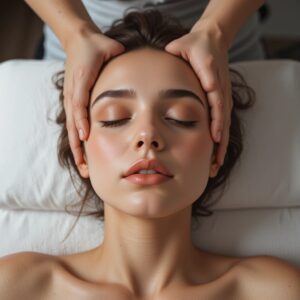The Guide to Gua Sha Massage: Benefits, Techniques, and Step-by-Step Instructions

Gua Sha massage has gained immense popularity worldwide as a natural and holistic approach to self-care, muscle recovery, and skin rejuvenation. This traditional healing technique, deeply rooted in East Asian medicine, involves using a specially designed tool to scrape or glide along the skin to promote circulation, release muscle tension, and enhance overall well-being. Whether you’re new to Gua Sha or looking to refine your technique, this comprehensive guide will walk you through everything you need to know, from its benefits and techniques to a detailed step-by-step method for effective application.
What is Gua Sha and How Does It Work?
Gua Sha (pronounced “gwah-shah”) is a centuries-old practice originating from traditional Chinese medicine (TCM). The term “Gua” means “scrape,” while “Sha” refers to the red or purplish marks that sometimes appear on the skin after treatment. These marks indicate the release of toxins and improved circulation, which are key components of the healing process.
Gua Sha is performed by using a smooth-edged tool, typically made from jade, rose quartz, or stainless steel, to apply gentle pressure and strokes along specific areas of the body or face. The technique is believed to help release stagnation in the body’s energy flow (Qi) and improve blood circulation, ultimately reducing inflammation, tension, and discomfort.
The Science-Backed Benefits of Gua Sha Massage
Gua Sha is more than just a wellness trend—it has scientifically backed benefits that can enhance both physical and mental health. Some of the most well-known benefits include:
1. Improved Blood Circulation
One of the primary benefits of Gua Sha is its ability to boost microcirculation in the treated areas. This increased blood flow helps deliver oxygen and nutrients to the muscles and skin, promoting faster healing and overall vitality.
2. Relief from Muscle Tension and Pain
Studies suggest that Gua Sha can be an effective treatment for muscle soreness, chronic pain, and stiffness. By breaking up fascia restrictions and stimulating the lymphatic system, it helps relax tight muscles and reduce discomfort.
3. Lymphatic Drainage and Detoxification
Gua Sha encourages the movement of lymphatic fluids, which helps the body detoxify naturally. This process reduces swelling, enhances immune function, and improves skin health.
4. Skin Rejuvenation and Anti-Aging Effects
Facial Gua Sha is known for its ability to reduce puffiness, improve skin elasticity, and stimulate collagen production. With consistent use, it can help diminish fine lines, promote a lifted appearance, and enhance the skin’s natural glow.
5. Migraine and Headache Relief
Many people use Gua Sha therapy to relieve headaches and migraines by focusing on tension-prone areas such as the neck, shoulders, and temples. This technique helps reduce muscle tightness that often contributes to headaches.
6. Stress Reduction and Relaxation
The gentle, rhythmic motions of Gua Sha create a soothing effect that can help lower cortisol levels and promote relaxation, making it an excellent addition to any self-care routine.
How to Perform Gua Sha Massage at Home: Step-by-Step Guide
To get the best results from your Gua Sha massage, it’s important to follow the correct techniques and use the right tools. Below is a detailed guide on how to perform a Gua Sha massage for both the face and body.
Step 1: Choose the Right Gua Sha Tool
Gua Sha tools come in different shapes and materials. Jade and rose quartz tools are commonly used for facial massage, while stainless steel or bian stone tools are preferred for body treatments due to their durability.
Step 2: Prep Your Skin with Oil or Serum
Before starting, cleanse your skin and apply a facial oil or body massage oil to ensure smooth gliding of the tool. This prevents unnecessary friction and enhances the benefits of the massage.
Step 3: Use the Correct Angle and Pressure
Hold the Gua Sha tool at a 30-45 degree angle against your skin and use gentle to medium pressure. Avoid pressing too hard, as this can cause unnecessary bruising or irritation.
Step 4: Follow Proper Stroke Directions
- For the Face: Start at the center and move outward toward the hairline. Work in upward strokes for a lifting effect and downward strokes for lymphatic drainage.
- For the Neck: Glide the tool from the base of the neck up toward the jawline to release tension and promote circulation.
- For the Shoulders and Back: Use long, firm strokes to break up muscle tension and alleviate stiffness.
- For the Legs and Arms: Stroke in an upward motion to encourage blood flow and reduce swelling.
Step 5: Repeat Strokes and Breathe Deeply
Perform each stroke 3-5 times in a slow, controlled manner. Take deep breaths to enhance relaxation and improve oxygen flow throughout the body.
Step 6: Clean Your Gua Sha Tool
After each session, wash your tool with warm water and mild soap to prevent bacteria buildup.
Common Mistakes to Avoid
- Using excessive pressure: Gua Sha should not be painful; gentle to medium pressure is sufficient.
- Skipping the oil application: Dry scraping can cause irritation and discomfort.
- Inconsistent practice: For best results, perform Gua Sha 3-4 times per week.
- Not following proper stroke directions: Always work in the correct directions to maximize benefits.
Who Should Avoid Gua Sha?
While Gua Sha is generally safe, it is not recommended for individuals with:
- Open wounds or skin infections
- Blood clotting disorders
- Severe acne or sunburn
- Recent Botox or filler injections (wait at least two weeks)
Final Thoughts: Make Gua Sha a Part of Your Wellness Routine
Gua Sha is a powerful, natural therapy that offers numerous benefits for both the body and mind. Whether you’re looking to enhance your skincare routine, relieve muscle tension, or simply indulge in a relaxing ritual, incorporating Gua Sha into your self-care regimen can be a game-changer. By following the correct techniques and being consistent, you can unlock its full potential for improved well-being.